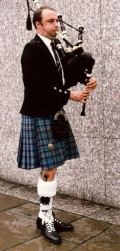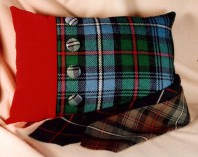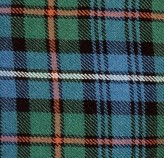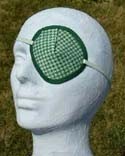How to Create a Plaid
If you are lucky enough to have a tartan to represent your name, you can reproduce the fabric into needlepoint with a few simple steps.
For instructions on creating the pillow, click Plaid Pillow.
First, it is best if you find a fabric sample that represents your name. Here on the right, is the Roberts’ or Robertson’s plaid. (If you do not have a fabric swatch, find a picture of the plaid and just guess the count.)
Find a starting point on the plaid and count the colored woven threads in a section. Divide the number by 2. For example, if the block of color is 26 threads, divide it by 2. On paper, write down 13. (By dividing the numbers by 2, the plaid will be smaller which will give you a nice repeat on the canvas.)
You will now repeat for the next block of color. You will count and divide each color block on the plaid until you have reached the area which repeats the pattern.
If the number is odd, add 1 more. (Example, you have 5 threads, 5 + 1 = 6.) Now divide by 2. (Six divided by 2 which equal 3.) You will write 3 for this section of threads.
If the plaid has the same pattern in one direction as the other, then you will not need to count the vertical pattern.
Plaids can be any color combination and count. You may wish to create your one-of-a-kind creation by taking colors and playing with the count.
Hound’s Tooth fabric is 2 rows of one color and 2 rows of another. Traditionally, Hound’s Tooth is white with another color. Here on the right, you can see an eye patch stitched in green and yellow.
To stitch your plaid on canvas, please look at Chottie’s Plaid. This stitch technique will create a back identical to the front which is excellent for handbag flaps, men’s ties or coasters. You will not need to cover the backside.









